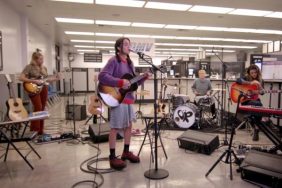Photo: Steve Havoc, Siouxsie Sioux, ‘Debbie’, 1970s.
Picture it: King’s Road, London. 1971. Malcolm McLaren starts a shop called Let It Rock, featuring clothes designed by his then-girlfriend, Vivienne Westwood. It was a period piece. The pink signage and “Odeon” wallpaper was designed to put you in the mood to purchase drape jackets, tight pants, and creepers. Needless to say, it was here today, gone by 1973, when the show as renamed Too Fast To Live, Too Young To Die, as the dynamic duo updated the look to early ‘60s rocker styles that came and went, until they found their truth living in the present tense: SEX.
Also: Girls On Film | 70s Punk Legends: Photographs by Jim Jocoy
It got your attention. Loud and clear. The word “SEX” was written in pink foam letters that ran four feet high above the door, the walls covered in graffiti from SCUM Manifesto and chicken wire. Inside was another world, all red carpeting and rubber curtains, fetish and bondage gear. It was just the sort of affront that McLaren enjoyed, while also being a proper honey trap. The shop became the spot for London’s Blight Young Things.

Clash, Anarchy tour, 1976.
McLaren found his foothold, and from it, he engineered the Sex Pistols, a glorious gob in the eye to respectability and intolerance. Punk, which had first come up in the streets of the New York City, translated flawlessly across the globe. The Swinging Sixties proved to be a fad. It came and went, consuming everything and leaving nothing in its wake. The kids were disillusioned and disgusted, and they disdained gentility. In the words of Charles Dickens, “It was the best of times, it was the worst of times.”
In celebration, Michael Hoppen Gallery, London, presents PUNK, now on view through August 26, 2016. The gallery is located just off King’s Road, coming back around to where it al began. The exhibition features vintage photographs by Ray Stevenson, Peter Price, and Paul Revere, among others, bringing us back to places like the 100 Club, with its low ceilings and its stuffy air, alongside the likes of Soo Catwoman, Johnny Rotten, and the Clash.

Soo Catwoman and Philip Salon, St James Apartment, 1976
The beauty of punk is in its originality, in its absolute unlikeness anything the world had previous heard or seen. Stripped of all pretensions, what remains is the absolute disdain of youth for the phoniness of modern life. Free from the square confines of thinking inside the box, artists, musicians, designers, photographers, and writers remade the world as they saw it.
And what a vision it was: a nihilism so glamorous and tragic that it was the snake devouring its tail, consuming itself in a blaze of glory that belies its romantic soul. And that’s why these photographs are so inspiring. This was art for art’s sake, and it went the length, setting a very high standard for the cosmic cocktail of authenticity: one part style, one part cool, and three parts FTW.

Malcolm McClaren, Paul Cook, Wessex Studios, 1976
All photos: © Ray Stevenson. Courtesy of Michael Hoppen Gallery.
Miss Rosen is a New York-based writer, curator, and brand strategist. There is nothing she adores so much as photography and books. A small part of her wishes she had a proper library, like in the game of Clue. Then she could blaze and write soliloquies to her in and out of print loves.








